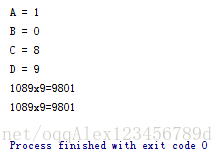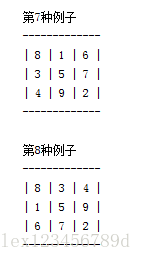Python习题及编码讲解
Python习题及编码讲解
一、习题讲解:
1.1 输入一行字符,分别统计出其中英文字母、空格、数字和其它字符的个数:
while 1:
strings = input("Please inpur a string(quit will be exit): ")
alpha, dig, space, other = 0, 0, 0, 0
if strings.strip() == "quit":
exit(1)
for i in strings:
if i.isdigit():
dig += 1
elif i.isspace():
space += 1
elif i.isalpha():
alpha += 1
else:
other += 1
print("alpha = {0}".format(alpha))
print("dig = {0}".format(dig))
print("space = {0}".format(space))
print("other = {0}".format(other))解析:
1、设置一个while循环,如果需要退出则输入quit即可退出程序。
2、设置数字、字母、空格、其他字符的默认取值为0,使用input( )函数并使用for、if循环嵌套遍历计算输入的内容。
3、当输入一段内容后,程序会根据函数判断这段内容中存在的数字、字母、空格、其他字符的数量并打印出来。
4、isdigit( )函数判断是否数字;isalpha( )判断是否字母; isspace( ) 判断是否为空。
1.2 ABCD乘9=DCBA,A=? B=? C=? D=? 答案:a=1,b=0,c=8,d=9 1089*9=9801:
for A in [1]:
for B in range(0,10):
for C in range(0,10):
for D in [9]:
if ((1000*A + 100*B +10*C + D)*9 == 1000*D + 100*C + 10*B + A ):
print("A = {0}".format(A))
print("B = {0}".format(B))
print("C = {0}".format(C))
print("D = {0}".format(D))
print("{0}{1}{2}{3}x9={4}{5}{6}{7}".format(A,B,C,D,D,C,B,A))
#或者:
print("{0}{1}{2}{3}x9={3}{2}{1}{0}".format(A,B,C,D))解析:
1、从题目要求中可以看出A、D最大取值分别只能为1和9;B、C取值为0到9,固取值如A[1]、B[0,10]、C[0,10]、D[9] 。
2、根据题目要求1089*9=9801;可使用if循环推算出(1000*A + 100*B +10*C + D)*9 == 1000*D + 100*C + 10*B + A 。
3、然后分别输出A、B、C、D和1089*9=9801的值。
number = list()
for i in range(1,10):
number.append(i)
count = 1
for A in number:
a = number.copy()
a.remove(A)
for B in a:
b = a.copy()
b.remove(B)
for C in b:
c = b.copy()
c.remove(C)
for D in c:
d = c.copy()
d.remove(D)
for E in d:
e = d.copy()
e.remove(E)
for F in e:
f = e.copy()
f.remove(F)
for G in f:
g = f.copy()
g.remove(G)
for H in g:
h = g.copy()
h.remove(H)
for I in h:
if (A+B+C == D+E+F == G+H+I == A+D+G == B+E+H == C+F+I == A+E+I == G+E+C == 15):
print('''
第{9}种例子
-------------
| {0} | {1} | {2} |
| {3} | {4} | {5} |
| {6} | {7} | {8} |
-------------'''.format(A,B,C,D,E,F,G,H,I,count))
count += 1解析:
1、设置列表number并遍历1~9的数。
2、循环 A~I 的值,使用copy函数赋予给新值,并移除已循环的值,以此类推到 I 结束。
3、最后根据循环到 I 的每3个的值进行相等计算是否等于15:A+B+C == D+E+F == G+H+I == A+D+G == B+E+H == C+F+I == A+E+I == G+E+C == 15。
1.4 阶乘累加:
def jc(n):
result = 1
if n == 0:
return result
else:
for i in range(1,n+1):
result *= i
return result
n = input("Please input number n: ")
count = 0
for i in range(0,int(n)+1):
count += jc(i)
print("count = {0}".format(count))解析:
1、创建一个函数名为 jc,如果n的值为0则等于1,如果n为大于1的值,则进行for遍历计算赋值。
2、当输入相应的值时,程序会进行判断并将阶乘相加输出对应的结果,如上图。
二、Python编码介绍:
1.1 Python支持中文的编码:
utf-8 , gbk , gb2312
uft-8 国际通用,常用有数据库、编写代码
gbk 如windows的cmd使用:

python2 默认支持的是ASCII码;
python3 默认则已支持UTF-8。
1.2 Python中如何进行编码的修改和使用
import sys
reload(sys)
print(sys.getdefaultencoding())
sys.setdefaultencoding(“utf-8”)
print(sys.getdefaultencoding())- python2也可以使用如下的转码的过程:
源有编码 -> unicode编码 -> 目的编码
decode("UTF-8") 解码 --> unicode --> encode("gbk") 编码







